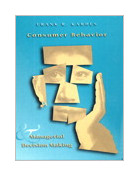|
||
• wydawnictwa polskie
• Zamów informacje o nowościach z wybranego tematu • kontakt
• Cookies na stronie |
CONSUMERS BEHAVIOR. MANAGERIAL DECISION MAKINGKARDES F.wydawnictwo: ADDISON-WESLEY , rok wydania 2000, wydanie Icena netto: (Special Offer: Discount 50% of the price)
Consumer Behavior For courses in Consumer Behavior. Kardes approaches the subject of consumer behavior by using experimental psychology as the foundation, and presents his material in three overlapping sections. The text not only discusses the principles and scientific research of consumer behavior but demonstrates how companies and organizations use them every day. How consumers acquire, remember, and use product knowledge (Section I). Provides students with the basic building blocks needed for understanding what information consumers use and how they use it. Persuasion and influence (Section II). Shows students how to persuade and influence consumers more successfully through the effective use of advertising, promotion, and other marketing tools. Managerial decision making (Section III). Helps students use the arsenal of marketing tools and principles that is available to them, and helps them understand their own problem-solving and decision-making skills more fully. Taking Issue boxes In each chapter. Uses real companies or situations to discuss ethical issues in consumer behavior e.g., the use of credit card logos to encourage spending, new on-line stock trading, and Coca Cola's agreement with Boys & Girls Clubs of America to sponsor tournaments and promote Coke products. Making the Decision boxes Shows how companies implement consumer behavior principles in their marketing and advertising campaigns or how consumer decisions affect companies. These boxes profile both solid and questionable company decisions, e.g., one box discusses different companies' use of the Internet to enhance product demonstrations and provide additional consumer information, and another discusses Mercedes' decision to build a low-priced, basic car, which fights against its premium image in the marketplace. Websites, Advertisements, photos, and illustrations Interspersed throughout. Shows students how companies appeal to consumers. The Websites demonstrate how marketers are using the Internet's global reach to tap new markets; photographs of products discussed in the text supplement chapter discussions; and colorful graphs and charts summarize and help reinforce major text concepts. Strong pedagogical support Chapter outlines, chapter-opening vignettes, chapter summaries, key concepts lists, end-of-chapter Thinking Scientifically questions, and end-of-chapter Scientific Situations exercises.
I. HOW CONSUMERS ACQUIRE, REMEMBER, AND USE PRODUCT KNOWLEDGE. 2.
Consumer Attention and Comprehension. II. PERSUASION AND INFLUENCE. 6. The
Message-Learning Approach to Persuasion. III. MANAGERIAL DECISION MAKING. 11.
Segmentation Strategies. 494 pages Księgarnia nie działa. Nie odpowiadamy na pytania i nie realizujemy zamówien. Do odwolania !. |


